Lithium Battery Car Chargers: Advanced Charging for Modern Vehicles
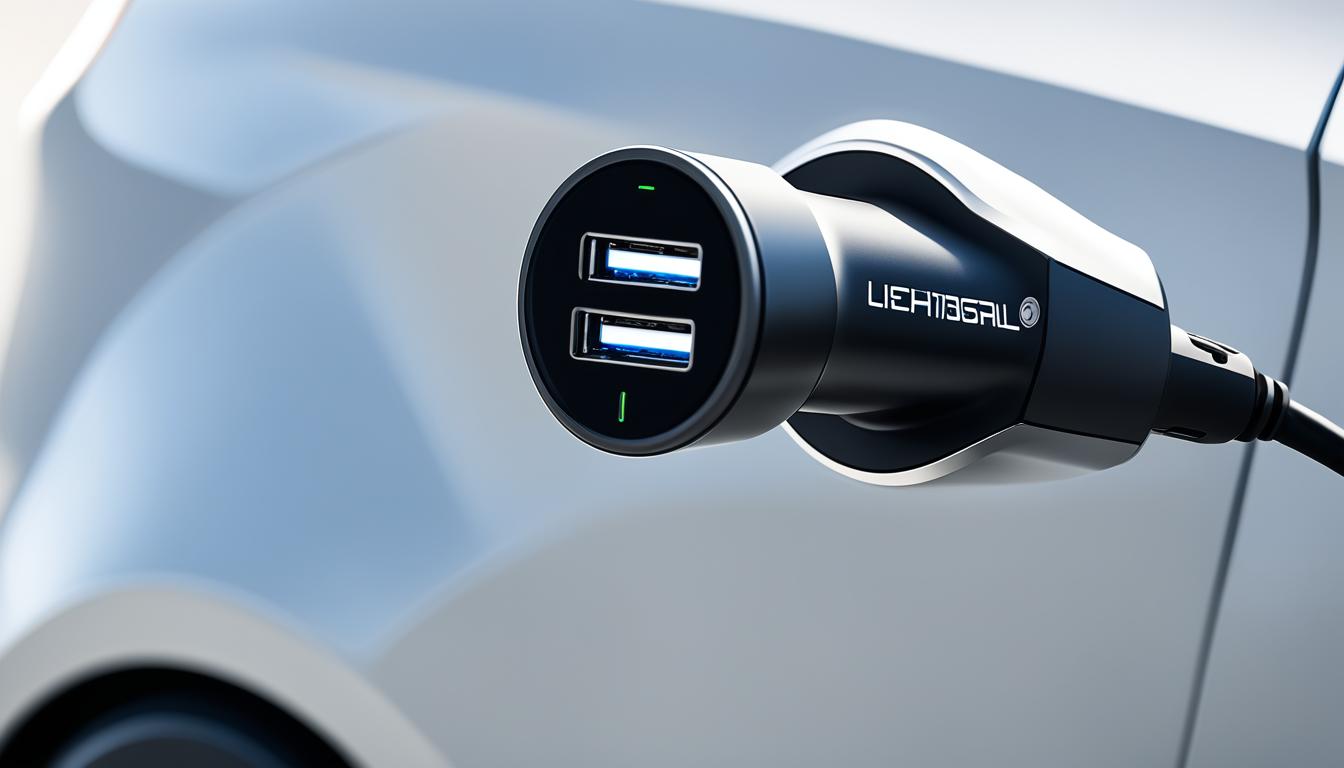
The world is moving towards sustainable transport, making lithium battery car chargers more popular than ever. These advanced devices are changing how we charge our electric vehicles (EVs). They offer quick, safe, and easy charging solutions. In this guide, I’ll dive into the latest in lithium battery car charger technology. I’ll show how they’re making our future greener and more energy-independent.
Key Takeaways
- Lithium battery car chargers are the game-changing technology powering the future of electric vehicles.
- These advanced chargers offer faster, safer, and more efficient charging solutions for EV owners.
- Lithium-ion technology in car chargers provides longer battery life and better performance.
- Home EV charging stations and portable lithium battery car chargers are essential for a convenient and sustainable driving experience.
- Understanding the different types and specifications of lithium battery car chargers is key to choosing the right one for your needs.
The Rise of Electric Vehicles and the Need for Efficient Charging
The electric vehicle (EV) revolution is growing fast. More drivers are choosing electric vehicle charging solutions. This means there’s a big need for easy and quick EV battery charger options. Switching to electric cars helps the planet and makes charging at home with a home EV charging station very convenient.
The Environmental Benefits of EVs
Electric vehicles are becoming popular because they’re good for the planet. They don’t produce the harmful emissions that gas cars do. By choosing an electric car, drivers help reduce pollution and fight climate change.
The Convenience of Charging at Home
Charging your EV at home is a big plus. With a home EV charging station, you can top up your car overnight. This means you won’t need to stop at public charging spots, saving you time and hassle.
“The rise of electric vehicles has been a game-changer in the transportation industry, offering a more sustainable and eco-friendly alternative to traditional gasoline-powered cars.”
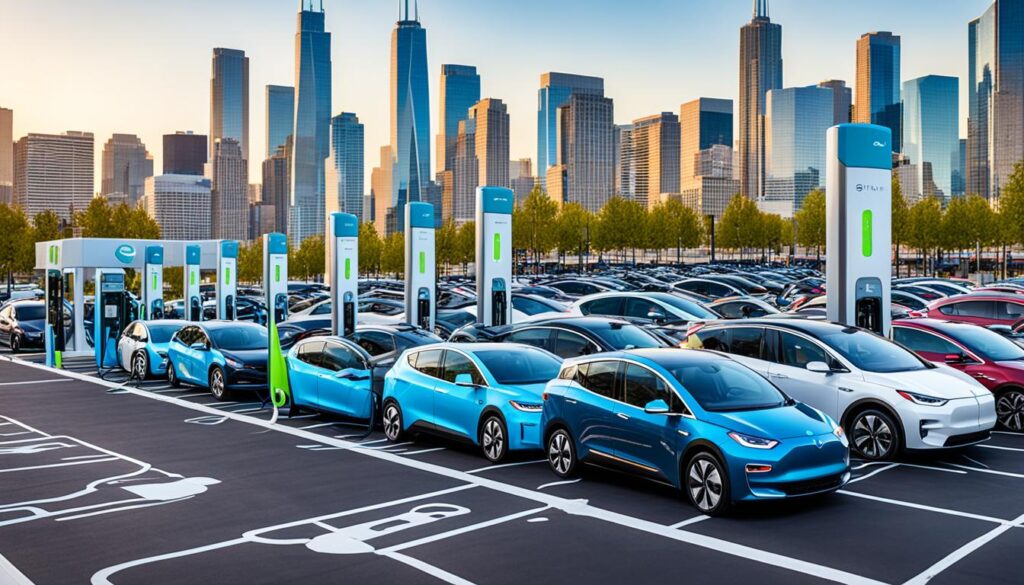
More people are choosing EVs, making electric vehicle charging solutions more important. With the latest EV battery charger tech and home EV charging stations, drivers can enjoy a greener way to get around. And they can charge their cars easily from home.
Understanding Lithium Battery Car Chargers
Lithium battery car chargers are key to the growth of electric vehicles (EVs). They efficiently and safely recharge the lithium-ion batteries that power EVs. Let’s explore the technology and principles behind these chargers to understand their vital role in the EV world.
These chargers change AC from your home’s grid to DC for your EV’s battery. This process, called rectification, is vital for keeping your vehicle’s lithium-ion battery working well.
Lithium battery car chargers have many features that EV owners rely on. They have advanced power management and safety features for a reliable charge. Knowing how these chargers work helps you make smart choices for your EV’s power and keeps the battery healthy.
| Key Features of Lithium Battery Car Chargers | Benefit to EV Owners |
|---|---|
| Power conversion (AC to DC) | Ensures safe and efficient charging for lithium-ion batteries |
| Advanced power management | Extends battery life by regulating charging speed and current |
| Built-in safety mechanisms | Protects against overheating, overcharging, and other hazards |
| Compact and portable design | Enables convenient charging at home or on the go |
As electric vehicles become more popular, lithium battery car chargers are more important than ever. By understanding these chargers, EV owners can charge their vehicles efficiently and safely. This ensures their batteries last longer.
“Lithium battery car chargers are the unsung heroes powering the rise of electric vehicles.”

Lithium Battery Car Charger Types and Specifications
Choosing the right lithium battery car charger is crucial for your electric vehicle. You have options from Level 1 chargers to Level 2 chargers, each with its own benefits. Let’s explore these options to find the best one for you.
Level 1 Chargers: Slow but Steady
Level 1 chargers use standard household outlets and are the simplest type. They charge your car at a slow but steady rate. This is great for those who can charge their car overnight at home. It’s a cost-effective choice.
Level 2 Chargers: The Happy Medium
For faster charging, Level 2 chargers are a good pick. They offer a power output of 3.3 to 19.2 kilowatts. This means you can charge your car quicker than with Level 1 chargers. Level 2 chargers are found in homes, workplaces, and public spots, offering a balance between speed and convenience.
| Charger Type | Charging Speed | Typical Use Cases |
|---|---|---|
| Level 1 Charger | 1.4 to 1.9 kW | Overnight charging at home |
| Level 2 Charger | 3.3 to 19.2 kW | Home, workplace, and public charging stations |
| DC Fast Charger | 50 to 350 kW | Public charging stations for quick top-ups |
Knowing the different lithium battery car chargers helps you pick the right one for your needs. Whether you choose a Level 1, Level 2, or DC fast charger, make sure it fits your lifestyle and charging needs.
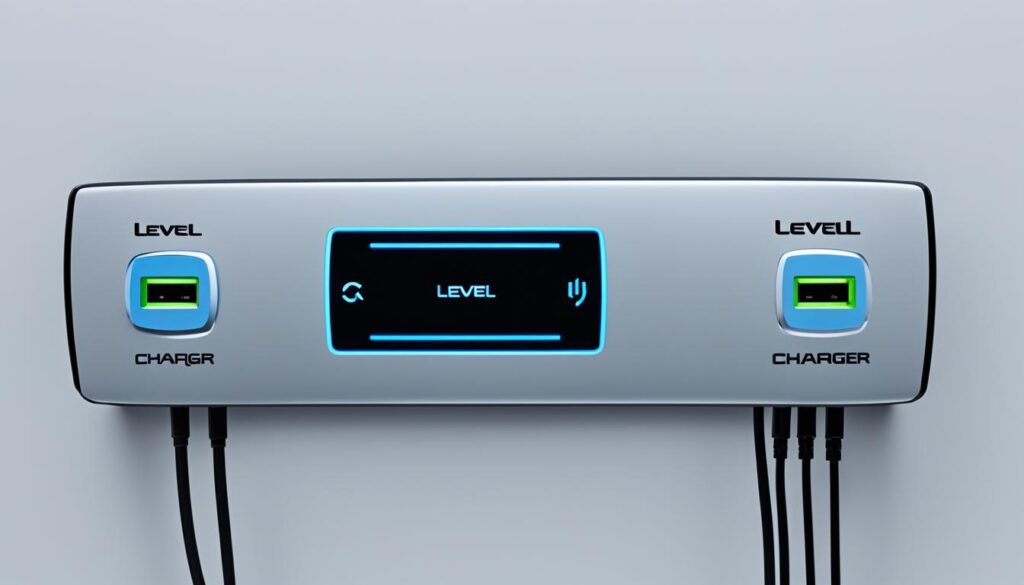
Factors to Consider When Choosing a Lithium Battery Car Charger
Finding the right lithium battery car charger can seem tough, but knowing what to look for helps. With more electric vehicles (EVs) on the road, picking a charger that fits your car and charges fast is key.
Compatibility with Your EV
First, make sure the charger works with your EV. Each EV has its own charging needs. It’s important to pick a charger that matches your car’s specs for safe and efficient charging.
Charging Speed and Power Output
Charging speed and power matter a lot too. A fast charger cuts down the time it takes to fill up your car. Choose chargers with high power for quicker and more efficient charging.
| Feature | Importance |
|---|---|
| Compatibility | Ensures a safe and efficient charging experience for your specific EV model. |
| Charging Speed | Reduces the time it takes to fully charge your vehicle, improving convenience. |
| Power Output | Enables faster charging and maximizes the efficiency of your lithium battery car charger. |
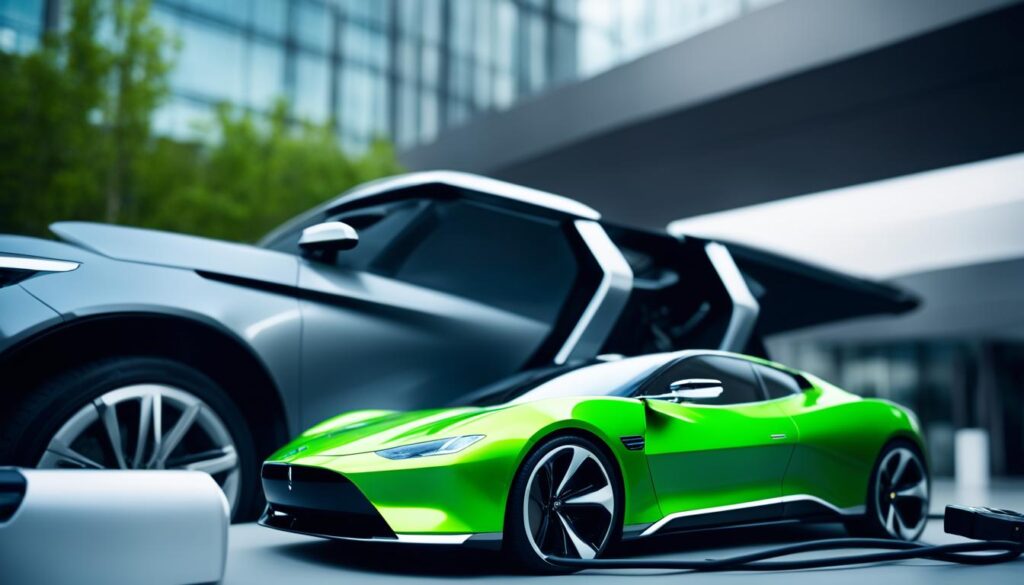
Think about these factors to find the best lithium battery car charger for your EV. The right charger means a smooth and efficient way to keep your car ready to go.
Installing a Home EV Charging Station
For many electric vehicle (EV) owners, a home charging station is a big step forward. I’ll guide you through installing a home EV charging station. We’ll look at the electrical needs and picking the best spot for it.
Understanding Electrical Requirements
Before you start, know what your home’s electrical system can handle. Make sure it can support the charging station’s power. It’s wise to talk to a licensed electrician. They can tell you if you need to upgrade or change things for the station.
Choosing the Right Location
Choosing where to put your EV charging station is key. Think about how close it is to where you park your car, how easy it is to get to, and if there’s a good outlet nearby. The spot should be easy to reach for charging, look good, and not block paths or traffic.
| Electrical Requirement | Recommended Specification |
|---|---|
| Voltage | 240V |
| Amperage | 32A |
| Circuit Breaker | 40A |
| Wiring | 6-gauge copper wire |
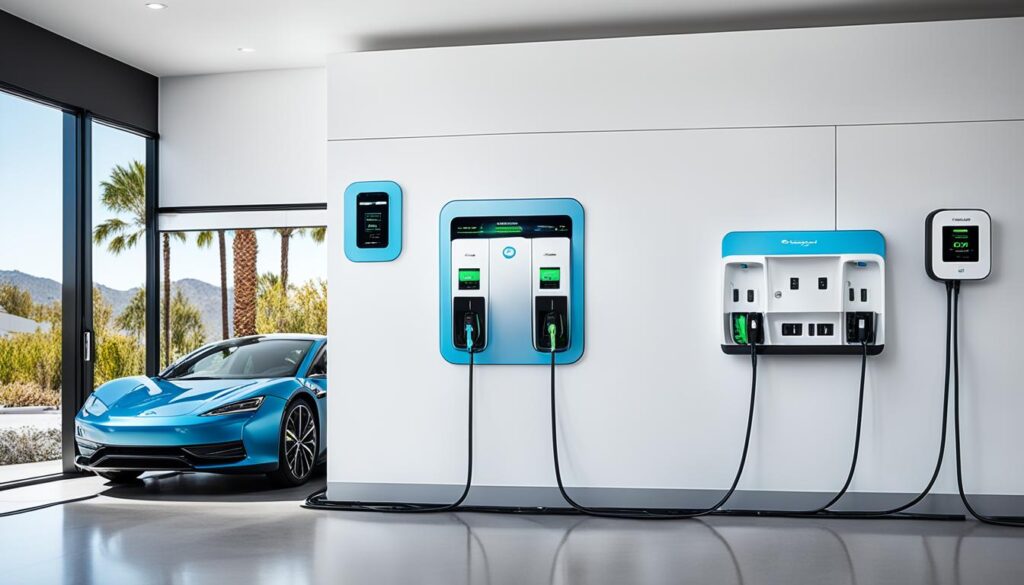
“Proper installation and placement of your home EV charging station can greatly enhance the convenience and efficiency of charging your electric vehicle.”
Portable Lithium Battery Car Chargers for On-the-Go Charging
Home charging stations are great, but sometimes you need to charge your electric vehicle (EV) while on the move. Portable lithium battery car chargers are key for EV owners. They provide a reliable way to charge your car when you’re away from home.
These chargers are small and light, making them easy to take with you. They’re perfect for road trips, sudden power cuts, or when you need to charge your EV elsewhere. Thanks to lithium-ion tech, they give your EV a quick and efficient charge. This means you can drive with confidence.
- Convenience: Portable chargers let you charge your EV anywhere, so you don’t have to plan your trips around charging spots.
- Versatility: Many chargers work with different EV models, making them a flexible choice for various owners.
- Fast Charging: Some chargers offer on-the-go charging, giving your EV a quick boost when you need it.
| Feature | Benefit |
|---|---|
| Compact and Lightweight Design | Easy to transport and store in your vehicle |
| Multiple Charging Outputs | Able to charge multiple devices at once |
| Built-in Safety Features | Keep your EV and charger safe from overheating, overcharging, and other problems |
For road trips or unexpected situations, portable lithium battery car chargers are a must-have for EV owners. They offer on-the-go charging and convenience.
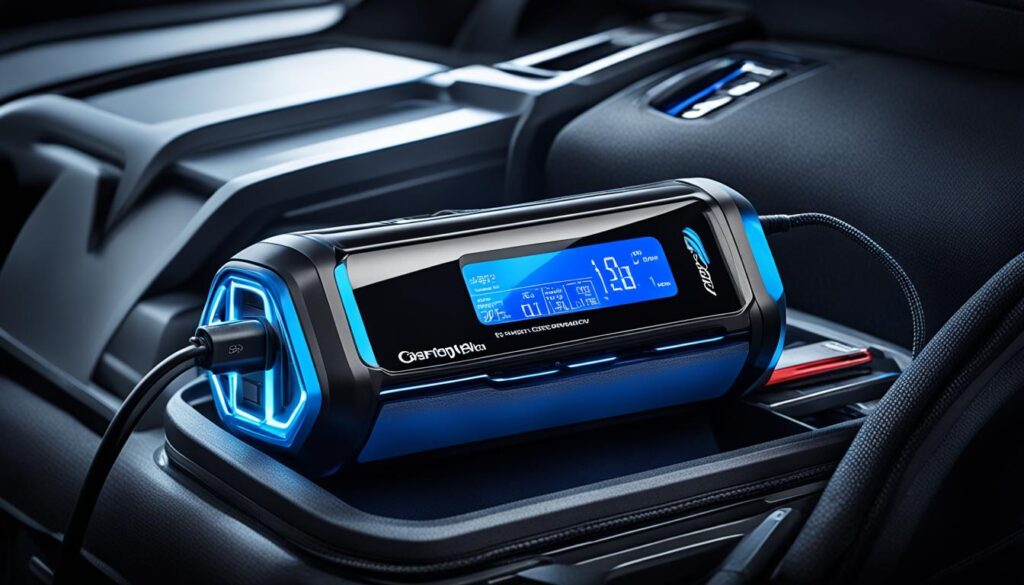
Maximizing Battery Life with Smart Charging Techniques
Keeping your electric vehicle’s lithium-ion battery healthy is key. Smart charging techniques help with this. By learning about battery management systems, you can charge your car better and make the battery last longer.
Understanding Battery Management Systems
A battery management system (BMS) is vital for your EV’s smart car charger. It watches over the charging and discharging of your lithium-ion battery. This keeps your battery working well and lasting longer. The BMS checks things like voltage, current, and temperature to keep the battery safe.
- The BMS makes sure each cell in the battery pack is balanced. This stops one cell from getting too full or too empty.
- It also keeps the battery from getting too hot, overcharged, or overdischarged. These issues can shorten the battery’s life.
- With the BMS, your smart car charger can give your EV’s battery just the right amount of power. This makes it more efficient and extends its life.
Having a strong battery management system is important for modern smart car chargers. This mix of smart charging and battery management keeps your EV’s battery running well for many years.
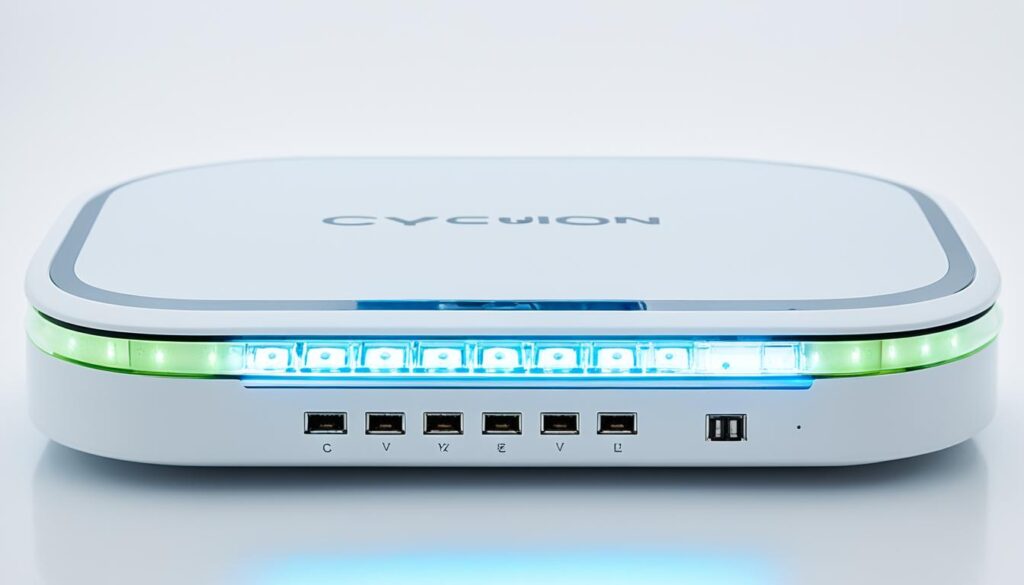
“Proper battery management is crucial for the longevity and performance of electric vehicles. The battery management system is the unsung hero that keeps your EV running at its best.”
The Future of Lithium Battery Car Chargers
The world of electric vehicles is changing fast, and so is the tech behind lithium battery car chargers. We’re seeing faster charging and better energy use. This makes the future of EV charging exciting for drivers and the planet.
Advancements in Charging Technology
One big change in the future of lithium battery car chargers is faster charging times. Scientists and companies are working hard to make charging quick, like in minutes, not hours. This will make EVs more convenient and help more people switch to electric cars.
Also, future chargers will use less energy to charge cars. This means they’ll be more efficient and better for the environment. It will also save EV owners money on energy costs.
Smart features like predictive charging and remote monitoring will make charging better. Drivers can plan their charging, check battery health, and get updates on their phone. It will make charging easier and more convenient.
“The future of lithium battery car chargers is an exciting prospect, with the promise of faster, more efficient, and smarter charging solutions that will revolutionize the way we power our electric vehicles.”
As more people want electric vehicles, charging tech will be key to a greener future. Lithium battery car chargers will get better, easier to use, and kinder to the planet. This means driving will be cleaner and more convenient.
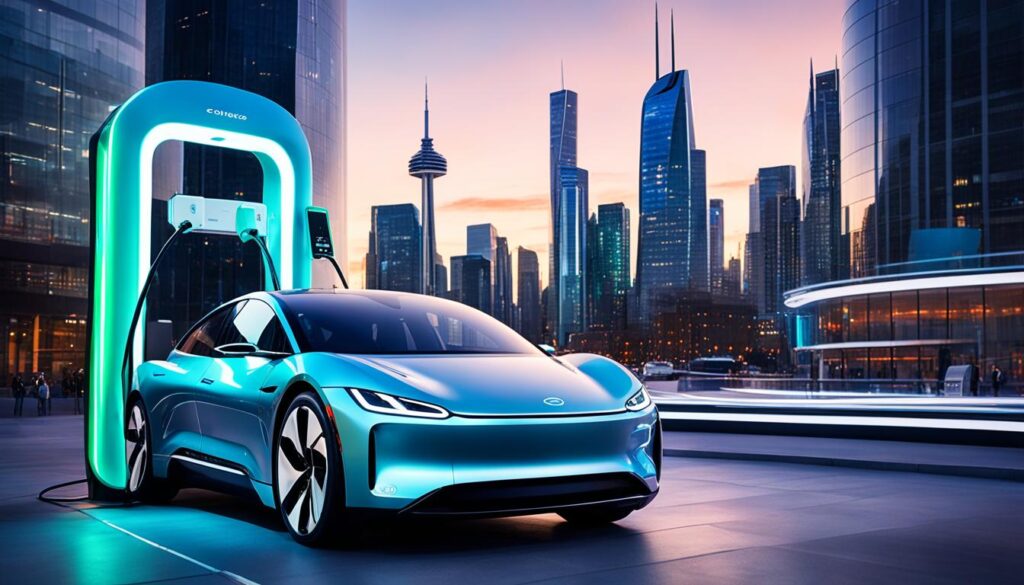
Lithium Battery Car Charger Safety and Maintenance Tips
As an electric vehicle (EV) owner, keeping your lithium battery car charger safe and well-maintained is crucial. Following the right steps can make your charger last longer and keep your EV in top shape. Here are some important tips for car charger maintenance and safety.
Start by reading and following the charger’s manual. Learn the best ways to charge your battery and avoid overcharging. Make sure your charger fits your EV’s battery. Also, watch out for extreme temperatures that can harm the charger and shorten your battery’s life.
Keeping your charger in good shape is important. Check the cables and connectors for damage and replace them if needed. Keep the charging port and charger clean to prevent charging issues. Think about getting a wall-mounted or freestanding charger. This can protect your device from the weather and reduce tripping risks.



















Leave a comment